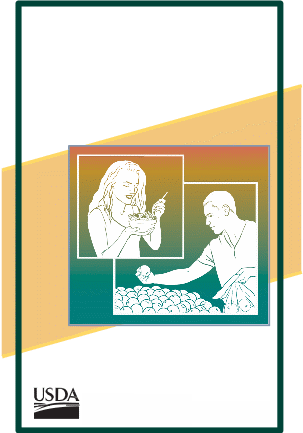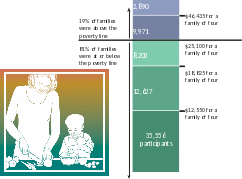Efnep Appendix 1 Efnep By 2014 Program Inputs
EFNEP Appendix 1 EFNAP BY 2014 PROGRAM INPUTS.docx
Expanded Food and Nutrition Education Program (EFNEP)
EFNEP APPENDIX 1 EFNEP BY 2014 PROGRAM INPUTS
OMB: 0524-0044
OMB No 0524-0044
Expires XXX
2018 IMPACTS
THE EXPANDED FOOD AND
NUTRITION EDUCATION PROGRAM
(EFNEP)
Improving Nutritional Security through Education
 United
States
Department
of
Agriculture
United
States
Department
of
Agriculture
National Institute of Food and Agriculture
@USDA_NIFA
A MESSAGE FROM EFNEP
Nutrition insecurity, reflected by poor nutrition, limited physical activity, unsafe food practices, and food insecurity is a significant national health concern. Poor health disproportionately affects minority and low-income populations. The Expanded Food and Nutrition Education Program (EFNEP) is the nation’s first nutrition education program and remains at the forefront of educational efforts to reduce nutrition insecurity of low-income families and youth today. Funded by the USDA’s National Institute of Food and Agriculture (NIFA), EFNEP supports program participants’ efforts toward self-sufficiency and nutritional health and well-being. EFNEP also combines hands-on learning, applied science, and program data to improve its effectiveness, efficiency, and accountability.
Collectively, 76 land-grant institutions deliver EFNEP through Cooperative Extension. Other federal programs and public and private efforts have joined with EFNEP to improve this nation’s nutritional health and well-being. EFNEP’s uniqueness lies in its deep community roots, university connections, and in hiring and training peer educators to teach low-income families to develop healthier behaviors. Peer educators help families understand and apply credible and practical nutrition information. EFNEP reaches close to 500,000 low-income adults and youth in rural and urban communities each year.
EFNEP’s success is largely due to its dedicated staff of professionals, peer educators, and volunteers; support of champions and partners; and the commitment of youth and adult participants who change their lives and then contribute in other ways to their families and communities. Each year, EFNEP produces measurable evidence that shows how low-income families succeed when they have access to NIFA programs. EFNEP exemplifies how NIFA’s promotion of science with purpose can achieve tangible positive outcomes for families, communities, and society.
Contemporary research and accountability reporting illustrate EFNEP’s high positive return on investment. Annual data consistently shows that more than 90 percent of adult EFNEP participants report improved behaviors following program involvement. Although research is limited, there is some evidence* that improved behaviors are sustained. Since 1969, EFNEP has reached more than 33 million low- income families and youth. Participants enhance their health by improving their nutrition, food safety, and physical activity practices.
![]()
Helen Chipman
National Program Leader Food and Nutrition Education
*EFNEP Research and Cost Benefit Studies: https://nifa.usda.gov/efnep-research-and-cost-benefit-studies
*EFNEP Reports: https://reeis.usda.gov/reports-and-documents/efnep
IMPROVING LIVES
REACHING LOW-INCOME FAMILIES
81% of EFNEP participants who reported income are at or below the poverty line, earning $25,100 a year or less for a family of four.

In 2018, NIFA received $67.9 million for land-grant university Cooperative Extension partners to conduct EFNEP in all 50 states, six U.S. territories, and the District of Columbia. EFNEP employed 1,822 educators who are members of the communities they serve. In turn, EFNEP educators worked directly with 90,325 adults and 345,550 youth. These educators tailored lessons on diet quality and physical activity, food resource management, food safety, and food security to meet the specific needs of their respective program participants.
REACHING DIVERSE POPULATIONS
At least 72% of all EFNEP adults are minorities.
 MINORITY
MINORITY
72%
28%
Non-minority or ethnicity not provided
 SHARED
STORIES
SHARED
STORIES
Food insecurity in urban areas of Missouri is quite prevalent. Our programs address the nutrition education needs of participants to improve food choices and health, and helps them gain skills to ensure their own food security. In one such program, we worked with partners at public schools and community organizations to create garden sites. The number of gardens grew from 44 in FY 16 to 200 in FY 17. Foods grown in these gardens are used for cooking lessons, taste testing, food banks, school lunch programs, and in participants’ homes.
University of Missouri - Columbia
In response to two category five hurricanes, EFNEP educators from St. Thomas taught junior high school students about nutriton, water quality, and how to keep food safe after a natural disaster. One student commented on a lesson that everyone everywhere could use: “I learned that I need to keep my food safe when my family does not have power. Freeze bottles of water before the storm comes. Keep foods cold with frozen water bottles.”
University of the Virgin Islands
EFNEP is famous for teaching nutrition and food preparation skills to low- income youth, including those with special needs. Instructors at UCONN Avery Point and the Waterford Community Center have run the gamut from introducing “new” foods that many thought the youth would not eat (they did) to teaching cooking tools and techniques. One participant who thought he couldn’t cut a strawberry, learned to prepare several food items. His teacher said, “No one thinks these kids can do anything, so they don’t even give them a chance… (Now) look how successful they have been.”
University of Connecticut
As we teach nutrition to participants, we focus on making healthier choices while staying within a budget. One lesson, which featured coupons and sale ads from grocery stores, was about how to find the best deals. The challenge was to develop a three-day grocery list of healthy items for one adult and child – and stay within a $25 spending limit.
Participants learned to create grocery lists by comparing prices, finding coupons, and using other benefits, such as the Special Supplemental Nutrition Program for Women, Infants, and Children (WIC). One participant noted, “This class has really helped me save money and time at the grocery store. I never knew how important it was to prepare a list.”
University of Illinois
 SAVING
MONEY
SAVING
MONEY
EFNEP graduates reported a collective
food cost savings of:
 IMPROVING
DIETS
IMPROVING
DIETS

93% of adults improved their diet, including consuming additional fruits and vegetables.

 SHARED
STORIES
SHARED
STORIES
North Carolina ranks 16th among states for hypertension, and EFNEP is recognized as a way to help people make simple changes to their lifestyles that could improve overall health. During a visit to her doctor, a young mom expressed concerns about her recent diagnosis of high blood pressure. Her doctor shared a flyer about EFNEP and an upcoming series of classes in her area. With the help of knowledge gained in the program, she lost weight and lowered her blood pressure to the point that she no longer had to take blood pressure medicine.
North Carolina State University
A high rate of homelessness and substance abuse plagues Spokane, Washington, and the surrounding valley. “Jessica,” who had just completed a drug rehabilitation program, was eager to lead a healthier life and lose the weight she had gained during her rehab. She heard about the positive changes her friends and neighbors had made after taking EFNEP classes. The nine lessons of the Eating Smart Being Active curriculum helped Jessica make positive lifestyle changes for herself and her family that resulted in some weight loss, improvements to overall health, and greater self-esteem.
Washington State University
A single mom was struggling with time, making ends meet, and feeding her children ages 8-13. She discovered EFNEP and enrolled in its 9-lesson series. Through the program’s Cent$ible Nutrition Cookbook, she was able to save time by using the many basic mixes to prepare easy and quick meals. Since completing the class, she saves almost $200 a month, is buying more fruits and vegetables, and her family is eating a more balanced diet. This mom is so impressed with the program that she plans to have her 13-year old take the classes.
University of Wyoming
Tuskegee EFNEP partnered with a middle school 7th grade class and a local farmer to show how eating fruits and vegetables is important to health and obesity prevention. Through a “fruit of the week” program, the EFNEP educator taught students how to cut fresh fruits into different shapes and sizes and present attractively for eating. Students taste-tested the fruits and evaluated them by nutrient content. The program was so successful that the school’s 8th graders decided to do a “vegetable of the week” program. Fresh produce that passed muster were included in the school cafeteria’s menu. The program improved the students’ nutrition, reduced school food waste, and stimulated economic development for local farmers.
Tuskegee University
CHANGING ADULT BEHAVIOR*
INFLUENCING YOUTH
91%
80%
Percentage of adults improving diet quality practices
Percentage of youth increasing knowledge or ability to choose healthy foods
80%
45%
Percentage of adults improving food resource management practices
Percentage of youth increasing knowledge or ability to prepare low-cost, nutritious foods
76%
50%
Percentage of adults improving food safety practices
Percentage of youth improving food safety and preparation knowledge or practices
77%
45%
Percentage of adults improving physical activity practices
Percentage of youth improving physical activity knowledge or practices
 *Previous
years’
adult
data
cannot
be
compared,
as
a
new
research
tested
“Adult
Food
and
Physical
Activity
Questionnaire”
(FPAQ)
was
used.
*Previous
years’
adult
data
cannot
be
compared,
as
a
new
research
tested
“Adult
Food
and
Physical
Activity
Questionnaire”
(FPAQ)
was
used.
STRONG HISTORICAL FOUNDATION
 EFNEP
has
made
a
difference
in
the
lives
of
American
families
and
children
since
1969.
It
began
as
a
pilot
project
in
Alabama
as
USDA
sought
solutions
to
concerns
of
poverty
and
hunger.
President
Lyndon
B.
Johnson
authorized
$10
million
in
1968,
and
in
1969
Congress
authorized
$30
million
EFNEP
has
made
a
difference
in
the
lives
of
American
families
and
children
since
1969.
It
began
as
a
pilot
project
in
Alabama
as
USDA
sought
solutions
to
concerns
of
poverty
and
hunger.
President
Lyndon
B.
Johnson
authorized
$10
million
in
1968,
and
in
1969
Congress
authorized
$30
million
under the Smith-Lever Act. Originally EFNEP was delivered by 1862 land-grant universities. In 2006 EFNEP expanded to include 1890 land-grant universities. Today, 76 institutions work with community partners nationwide.
MAINTAINING EXCELLENCE
Successful programs require constant attention.
Changing demographics of nutrition-insecure families, an increasing number of Americans at or below the poverty line, and burgeoning educational technologies present new challenges and opportunities for nutrition education programs. Ongoing EFNEP initiatives are underway to:
Receive and review periodic feedback to ensure program quality, integrity, and fidelity and meet changing needs of participants.
Confirm that adult and youth program indicators are scientifically valid and reliable.
Strengthen science-based learning methods and enhance teaching techniques with appropriate new technologies, social media, and social- ecological approaches.

| File Type | application/vnd.openxmlformats-officedocument.wordprocessingml.document |
| File Title | 2018 Impacts The Expanded Food and Nutrition Education Program (EFNEP) |
| Author | Chipman, Helen - NIFA |
| File Modified | 0000-00-00 |
| File Created | 2021-01-15 |
© 2026 OMB.report | Privacy Policy